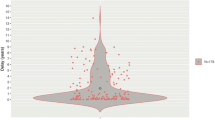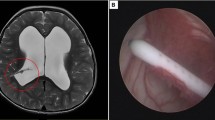Abstract
Background
Cerebrospinal fluid (CSF) shunt revision surgery represents a huge social and economic burden. Few studies, however, have evaluated shunt revision surgeries in the context of their avoidability, and existing data are from paediatric populations. Using ratings from an expert panel, we classified avoidable and unavoidable shunt revisions in a mixed cohort of CSF-shunt patients.
Methods
In a retrospective review of a prospectively maintained, single-centre database, we identified all shunt systems implanted for the first time over a 10-year period (2007–2016) and all subsequent revision surgeries with a follow-up of at least 1 year. A panel of five expert shunt surgeons classified each revision surgery as avoidable or unavoidable. Rates of each were calculated and correlated with clinical data.
Results
Of 210 revision surgeries (314 patients, mean age, 49.9 years; mean follow-up, 4.2 years), the panel judged 114 as unavoidable (54.3%) and 96 (45.7%) as avoidable. Level of surgeon education correlated with these rates, but even in the most experienced hands, 12.5% of revisions were classified as avoidable. Avoidable revisions occurred significantly earlier than unavoidable interventions (mean; 112 and 448 days, respectively) after the index surgery.
Conclusion
Rates of avoidable shunt revision surgery are alarmingly high, even in experienced hands. Avoidable revisions occur significantly earlier, predominantly within the first 3 months after the index surgery.




Similar content being viewed by others
References
Barton SE, Campbell JW, Piatt JH Jr (2013) Quality measures for the management of hydrocephalus: concepts, simulations, and preliminary field-testing. J Neurosurg Pediatr 11:392–397
Beez T, Steiger HJ (2018) Comparison of quality metrics for pediatric shunt surgery and proposal of the negative shunt revision rate. World Neurosurg 109:e404–e408
Dave P, Venable GT, Jones TL, Khan NR, Albert GW, Chern JJ, Wheelus JL, Governale LS, Huntoon KM, Maher CO, Bruzek AK, Mangano FT, Mehta V, Beaudoin W, Naftel RP, Basem J, Whitney A, Shimony N, Rodriguez LF, Vaughn BN, Klimo P (2019) The preventable shunt revision rate: a multicenter evaluation. Neurosurgery. 84(3):788–798
Dupepe EB, Hopson B, Johnston JM, Rozzelle CJ, Jerry Oakes W, Blount JP, Rocque BG (2016) Rate of shunt revision as a function of age in patients with shunted hydrocephalus due to myelomeningocele. Neurosurg Focus 41(5):E6
Iglesias S, Ros B, Martín Á, Carrasco A, Segura M, Ros A, Rius F, Arráez MÁ (2017) Factors related to shunt survival in paediatric hydrocephalus. Could failure be avoided? Neurocirugia (Astur) 28(4):159–166
Kaestner S, Kruschat T, Nitzsche N, Deinberger W (2009) Gravitational units may cause underdrainage in bedridden patients. Acta Neurochir 151:217–221
Kestle J, Drake J, Milner R, Sainte-Rose C, Cinalli G, Boop F, Piatt J, Haines S, Schiff S, Cochrane D, Steinbok P, MacNeil N (2000) Long-term follow-up data from the Shunt Design Trial. Pediatr Neurosurg 33(5):230–236
Lund-Johanson M, Svendsen F, Wester K (1994) Shunt failures and complications in adults as related to shunt type, diagnosis, and the experience of the surgeon. Neurosurgery 35:839–844
Piatt JH Jr (2014) Thirty-day outcomes of cerebrospinal fluid shunt surgery: data from the National Surgical Quality Improvement Program-Pediatrics. J Neurosurg Pediatr 14:179–183
Preuss M, Kutscher A, Wachowiak R, Merkenschlager A, Bernhard MK, Reiss-Zimmermann M, Meixensberger J, Nestler U (2015) Adult long-term outcome of patients after congenital hydrocephalus shunt therapy. Childs Nerv Syst 31:49–56
Reddy GK, Bollam P, Caldito G (2014) Long-term outcomes of ventriculoperitoneal shunt surgery in patients with hydrocephalus. World Neurosurg 81(2):404–410
Riva-Cambrin J, Kestle JR, Holubkov R, Butler J, Kulkarni AV, Drake J, Whitehead WE, Wellons JC 3rd, Shannon CN, Tamber MS, Limbrick DD Jr, Rozzelle C, Browd SR, Simon TD, Hydrocephalus Clinical Research Network (2016) Risk factors for shunt malfunction in pediatric hydrocephalus: a multicenter prospective cohort study. J Neurosurg Pediatr. 7(4):382–390
Shah SS, Hall M, Slonim AD, Hornig GW, Berry JG, Sharma V (2008) A multicenter study of factors influencing cerebrospinal fluid shunt survival in infants and children. Neurosurgery. 62(5):1095–1102 discussion 1102-3
Stone JJ, Walker CT, Jacobson M, Phillips V, Silberstein HJ (2013) Revision rate of pediatric ventriculoperitoneal shunts after 15 years. J Neurosurg Pediatr 11(1):15–19
Tejedor-Sojo J, Singleton LM, McCormick K, Wrubel D, Chern J (2015) Preventability of pediatric 30-day readmissions following ventricular shunt surgery. J Pediatr 167:1327–1333
Tuli S, Drake J, Lawless J, Wigg M, Lamberti-Pasculli M (2000) Risk factors for repeated cerebrospinal shunt failures in pediatric patients with hydrocephalus. J Neurosurg 92(1):31–38
Venable GT, Rossi NB, Morgan Jones G, Khan NR, Smalley ZS, Roberts ML, Klimo P Jr (2016) The preventable shunt revision rate: a potential quality metric for pediatric shunt surgery. J Neurosurg Pediatr. 18(1):7–15
Wong JM, Ziewacz JE, Ho AL, Panchmatia JR, Bader AM, Garton HJ, Laws ER, Gawande AA (2012) Patterns in neurosurgical adverse events: cerebrospinal fluid shunt surgery. Neurosurg Focus 33(5):E13. https://doi.org/10.3171/2012.7.FOCUS12179
Author information
Authors and Affiliations
Corresponding author
Ethics declarations
Conflict of interest
The authors declare that they have no conflict of interest.
Ethical approval
All procedures performed in studies involving human participants were in accordance with the ethical standards of the institutional and/or national research committee and with the 1964 Helsinki Declaration and its later amendments or comparable ethical standards.
For this type of study formal consent is not required.
Additional information
Publisher’s note
Springer Nature remains neutral with regard to jurisdictional claims in published maps and institutional affiliations.
This article is part of the Topical Collection on CSF Circulation
Rights and permissions
About this article
Cite this article
Kaestner, S., Poetschke, M., Kehler, U. et al. Revision surgery following CSF shunt insertion: how often could it be avoided?. Acta Neurochir 162, 9–14 (2020). https://doi.org/10.1007/s00701-019-04083-0
Received:
Accepted:
Published:
Issue Date:
DOI: https://doi.org/10.1007/s00701-019-04083-0




